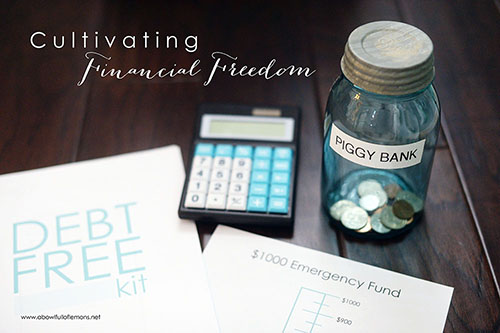Groceries tend to be a category in which many people overspend. Here are 10 tips for staying on track.
 |
| via freedigitalphotos.net |
1. Create a food budget!
Obvious, yes, but it’s important to start here. While the average American family spends 9-12% of its monthly income on food, the amount will vary based on your family size, ages of children, where you live, and whether or not you’re accommodating dietary restrictions. Start by looking at the receipts from the past several weeks and use them to calculate a baseline. Then try and lower it a bit over time as you’re disciplined to implement other steps.
2. Pull out the budgeted money in cash.
It is very easy to go over budget when you use a card. Even a store gift card may not keep you in check unless it’s loaded with the exact amount you’re limited to for that shopping trip. But when you know you must have enough cash to cover your purchases when you get to the register, it forces you keep a running total as you put items in the cart. (Otherwise, it can be a little embarrassing!)
3. Don’t carry your entire monthly grocery budget.
Take whatever you’ve budgeted for the month and divide it up into weeks if you shop weekly, two weeks if you shop bi-weekly, etc. Then bring only that amount and leave the rest at home. Always set aside a little margin for things you may need to pick up in the interim such as milk, bread, and eggs.
4. Shop less often.
If you are able to do this, it will cut down on the possibility of impulse purchases, simply because they’re not in your face as often. If you currently shop for groceries two or more times a week, change to once a week. If you shop once a week, try stretching it to every 10 days to two weeks.
5. Plan your menus ahead of time.
This method is another way to decrease impulse buying and also helps you strategically use the weekly grocery ads and plan your shopping trips. You can find lots of lovely printables for this, including Toni’s Menu Planning Mini Kit.
6. Shop at stores known for their lower everyday prices.
If it’s neither cost- nor time-effective for you to shop several different stores based on their ads, it can be helpful to frequent one that has consistently low prices. Depending on your location, this might include Aldi, WinCo, Grocery Outlet, Save-A-Lot, PriceRite, or Food 4 Less.
7. Use coupons.
Wait! Don’t run away! You don’t have to become an extreme couponer to implement this step, and neither does it mean you’ll be stocking up on a bunch of processed foods. Sometimes, a store will have coupons right in the ad for things you would buy anyway. And your favorite brands may share coupons if you sign up for emails or like their Facebook pages.
8. Use Favado (or other grocery apps).
I appreciate Favado because it’s nationwide, covering over 65,000 stores, and you can personalize it with your favorites. It allows you to comparison shop for a particular item and also view weekly sales and available coupons. The company actually collaborates with more than 80 “savings bloggers” all over the country so that regional deals are covered. Isn’t that cool? For a thorough review of Favado and its features, click here.
9. Don’t turn up your nose at leftovers.
Once a week, have a smorgasbord dinner. Pull out the leftovers from the past four days or so along with condiments and some fresh veggies and fruit. It not only saves money but also purges the fridge. Plus it gives you a little break!
10. Think outside the four walls of the grocery store.
Whether it’s growing your own produce, canning, keeping chickens for eggs, going in with another family on the purchase of a cow for beef, or purchasing in bulk and splitting it with a friend, there are many other ways to keep your grocery budget under control.
 |
| chicken coop photo courtesy of The Lumberjack’s Wife |
What are some things that have helped you stay on budget with groceries?
Please share in the comments!
For more budget tips from Melissa, visit her at her blog A Time For Everything
Melissa Kaiserman
Melissa is passionate about people living within their means and becoming--and remaining--debt-free. She is the owner of A Time for Everything, which includes both a shop where she sells handmade cash envelope system wallets and accessories, and a blog where she writes about frugal living, creating, and life in general. She's been blogging since 2007 and making pretty wallets since 2011.
Tags: a time for everything, budget, budgeting, contributors
A Time For Everything, Blog, Budget, budgeting, contributors, couponing, December 2013, envelope system, finances, menu planning Posted in
3 comments











Great tips. I do most of those. I shop weekly, with a list and a menu. I don’t use coupons – they rarely work for things I buy. I also add up my list before I go so I don’t have to keep track of my spending as I go. And I allow an extra $10 for things I forgot or good sales.
I usually go over budget, though, especially lately. Like you said, when I use my card, I don’t worry as much about it. Using cash forces me to stick to my budget. In fact, I usually come in under budget because I’m so much more careful. But I hate using cash. Because it forces me to stick to my budget! And it’s a pain. It’s not really a pain but I hate standing at the checkout counting it out. And having to stop at the bank to get it. But it really does work.
Great post.
This is a great post for this time of year. I can’t wait to start a new year and new budget. Christmas is so expensive!
I really appreciate this list! I need to be more disciplined with this portion of our budget, for sure! It seems like it is so easy to over spend on groceries for so many different reasons. Thanks for providing very practical and easy tips. I am going to start with carrying cash.